If you’re considering painting your home, you may be wondering what type of finish to choose. There are a variety of options available, each with its unique benefits. One option you may be considering is satin finish.
Have you ever wondered what gives satin paint its unique luster? Or why has it become such a popular choice for interior and exterior applications? If so, read on to learn all about the satin finish and how to use it to achieve beautiful results in your home.
The Beauty of Satin Finish:
A satin paint finish is an attractive option for your home. It has a soft, velvety appearance that is perfect for creating a luxurious feel in any room. Satin paint is also very durable and easy to clean, making it ideal for high-traffic areas like kitchens and bathrooms.
Satin finish paint is a mid-sheen paint that falls between eggshell and semi-gloss. It has a smooth, velvety finish that is easy to clean and resists stains and dirt.
If you’re looking for a beautiful and durable paint finish, satin is a great option. It’s perfect for creating a luxurious feel in any room and can withstand the wear and tear of high-traffic areas.
How is a Satin Finish created?
A satin finish is created by using a paint that has a low luster or sheen. This finish is less glossy than high-gloss paint but is more lustrous than flat or eggshell paint. This type of paint is usually applied to wood, metal, or glass. You can also use it on walls and ceilings.
Satin finishes are often used in rooms that receive a lot of traffic or moisture, such as kitchens and bathrooms. This type of finish is also famous for trim work and moldings because it is easy to clean and maintain.
To create a satin finish, you will need:
- A paintbrush
- Paint roller
- Satin paint
- Primer (optional)
Step 1: Choose the area you want to paint. If you are painting over an existing finish, make sure to sand and prime the surface first. This will help the new paint adhere better and create a more even finish.
Step 2: Pour some satin paint into a paint tray. Load your brush or roller with paint and begin to apply it to the surface.
Step 3: Use long, even strokes to apply the paint evenly. If you are using a roller, roll in one direction and then back over the area in the opposite direction.
Step 4: Allow the paint to dry completely before adding a second coat if desired.
Satin finishes are easy to create and can add a bit of shine and polish to any room. With just a few supplies and some patience, you can achieve a beautiful finish for years to come.
What are the Benefits of a Satin Finish?
A satin finish is a paint finish with a bit of luster, but it is not as shiny as a high-gloss finish. It is often used on trim and molding because it is easy to clean and does not show fingerprints as much as a glossy finish.
You can achieve satin finishes by using special paint with a built-in sheen or adding a gloss-Finish Paint to a Flat Paint. The amount of gloss in the paint will determine how shiny the final product is.
A satin finish is often chosen for used rooms, such as kitchens and bathrooms, because it is easy to clean. You can easily wipe away fingerprints and other marks with a damp cloth.
If you are looking for a paint finish that is durable and has a bit of shine, a satin finish is a great option.
How can I Care for my Satin Finish?

- Dust regularly. A soft, microfiber cloth is all you need to remove dust from your satin finish.
- Clean spills immediately. If you spill something on your satin finish, blot it up right away with a clean, dry cloth.
- Protect from heat and sunlight. Too much heat or direct sunlight can damage a satin finish, so keep your furniture out of the sun and away from heat sources.
- Use coasters. This will help prevent water rings and other damage from beverages.
- Be careful with harsh cleaners. Harsh chemicals can damage a satin finish, so stick to mild, gentle cleansers.
With a little bit of care, your satin finish will look beautiful for years to come!
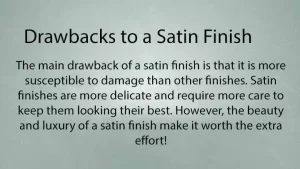
Do you have any tips for choosing a Satin Finish?
When choosing a satin finish, it is essential to consider the type of furniture you will be using it on. Satin finishes are best suited for tables, chairs, and other pieces that do not get a lot of wear and tear. If you are looking for a durable finish for a high-traffic area, you may want to choose a different finish.
Satin finishes are also available in a variety of colors. If you are unsure of what color you would like, it is best to ask for samples so you can see the finish in person before making a decision.
Satin finishes are beautiful and luxurious, but they require more care than other finishes. With a little bit of effort, you can keep your satin finish looking its best for years!
Satin Vs Semi-Gloss:
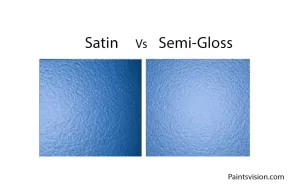
Satin finishes have a lower sheen than semi-gloss finishes, meaning they are not as shiny. The satin finishes are also more resistant to stains and scratches than semi-gloss finishes.
Satin finishes are best suited for areas that do not get a lot of wear and tear, such as living rooms and bedrooms. Semi-gloss finishes are more durable, and you can use them in high-traffic areas, such as kitchens and bathrooms.
When choosing a paint finish for your home, it is essential to consider the area you will be painting and the amount of use it will get. The satin finishes are a good choice for places that do not see a lot of wear and tear, while semi-gloss finishes are better suited for high-traffic areas.
Satin Vs Eggshell:
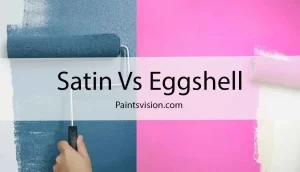
Satin paint is more durable than eggshells, and professionals use it in high-traffic areas such as hallways and kitchens. You can also use it on walls that are not perfectly smooth, as the finish will help to disguise any imperfections.
Eggshell paint has a softer sheen than satin and is better suited to low-traffic areas such as bedrooms and living rooms. It is also a good choice for walls in good condition, as the finish will highlight any imperfections.
If you are looking for a paint finish that will withstand the rigors of daily life, then satin is the best choice. On the other hand, Eggshell is a good choice if you are looking for a paint finish that is less expensive and easier to apply. The satin paint is more costly than eggshells, but it is also more durable and easier to clean.
Satin Finish Vs Gloss:
Satin and gloss are two types of paint finish people use in homes. Both finishes have a shiny appearance, but there are some differences between them.
Satin paint is more matte than glossy and is often used in homes because it is easier to clean. Glossy paint is more difficult to clean but can give a room a brighter appearance.
When deciding between satin and gloss, it is essential to consider the purpose of the room. If you are painting a space that will be high traffic, such as a kitchen or bathroom, you may want to use satin paint. If you are painting a room that you want to have a more elegant look, such as a dining room or living room, you may want to use gloss paint.
It is also essential to consider the type of paint you are using. Some paints are more likely to show imperfections than brush strokes. If you are painting a room that you want to have a flawless look, you may want to use high-gloss paint.
Satin and gloss paint both have their advantages and disadvantages. When deciding between the two, it is essential to consider the purpose of the room and the type of paint you are using.
You can paint the Satin finish with a more matte appearance than glossy. People often use it in homes because it is easier to clean.
Satin Finish Vs Matte:
Satin finish has a beautiful luster that catches the light, while matte finish appears flat and non-reflective. The two finishes you can achieve by using different types of paint, and each has its advantages.
You can create a Satin finish with a paint that contains more shine-producing properties, such as varnish or polyurethane. This type of paint is more durable and easier to clean than matte finish paint, making it ideal for areas that see a lot of traffic or you have to wipe it down frequently. However, satin finish paint can also be more challenging to apply evenly, and brush marks may be more visible.
Matte finish paint has a lower sheen than satin finish paint and contains less shine-producing properties. This type of paint is more forgiving to apply and is less likely to show brush marks. However, matte finish paint is not as durable as satin finish paint and may require more frequent touch-ups.
When choosing a paint finish for your home, it’s essential to consider the look you want to achieve and the level of durability and easy maintenance you need. Satin finish paint is an excellent choice if you want a beautiful, lustrous look that is durable and easy to clean. Matte finish paint is a good choice if you want a more forgiving finish that is less likely to show brush marks.
Matte Vs Satin Wall Paint:
Are you trying to decide between matte and satin paint for your walls? If you’re unsure which finish is right for you, read on to learn about the differences between matte and satin paint. Both finishes have unique benefits that can make either one a great option for your home.
Matte paint has a flat, dull finish that doesn’t reflect light. This makes it a good choice for hiding imperfections in walls and creating a more uniform look. It’s also an excellent option to avoid fingerprints and smudges on your walls.
Satin paint has a slight sheen that gives it a bit of shine. This makes it a good choice for walls that you want to have a bit of personality. It’s also more durable than matte paint, so it’s a good choice for high-traffic areas or homes with kids and pets.
So, which finish is right for you? If you’re looking for a uniform look that hides imperfections, go with matte paint. If you want your walls to have a bit of personality, go with satin paint. And if you need a durable finish that can stand up to kids and pets, go with satin paint.
Frequently Asked Questions:
Why do people paint walls flat?
Flat, or “matte,” paint has a dull finish and shows few imperfections. People often use it on ceilings and walls in rooms with little natural light or where the paint will be cleaned often, such as kitchens and bathrooms.
Do you paint walls or trim first?
The general rule of thumb is to paint the trim first, then the walls. This allows you to get a clean line where the wall and trim meet and also means that any paint drips or splatters will be less noticeable on the trim than on the walls.
What paint finish does Joanna Gaines use?
Joanna Gaines is known for her clean, classic style, which extends to her choice of paint finishes. She typically uses a satin finish for her walls, which gives them a subtle sheen and helps to hide imperfections.
Which is shinier satin or eggshell?
Satin and eggshell finishes have a slightly glossy sheen, but satin is typically shinier than eggshell. This makes it a good choice for areas with a lot of traffic or where you want the paint to be easy to clean.
What paint finish do designers use?
Designers often use satin paint for walls to strike a balance between a flat finish and a high-gloss finish. It has a bit of sheen, making it easier to clean than a flat paint, but it’s not as shiny as semi-gloss or high-gloss paint.
What is satin paint used for?
Satin paint is versatile for walls, trim, and other surfaces. You can use it in any room, but it’s especially popular in high-traffic areas and rooms that must be easy to clean.
What sheen is best for bedrooms?
The sheen you choose for your bedroom depends on your personal preference. Some people prefer a flat or matte finish for a calming effect, while others like a bit of gloss for easy cleaning. If you’re not sure, satin is a good middle-of-the-road option that strikes a balance between the two.
Conclusion:
The satin finish is a paint or coating with a soft, lustrous sheen. People often use it on woodwork, metalwork, and plastic. You can create the satin finish by using either a particular type of paint or varnish or by buffing the surface of the material until it has a smooth, even sheen.



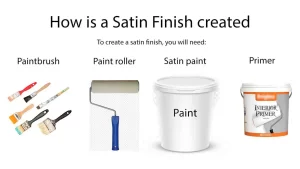

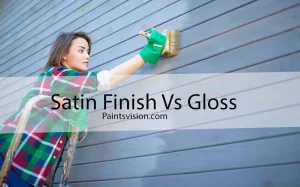
12 thoughts on “What is a Satin Finish? Stunning Uses in Your Home”